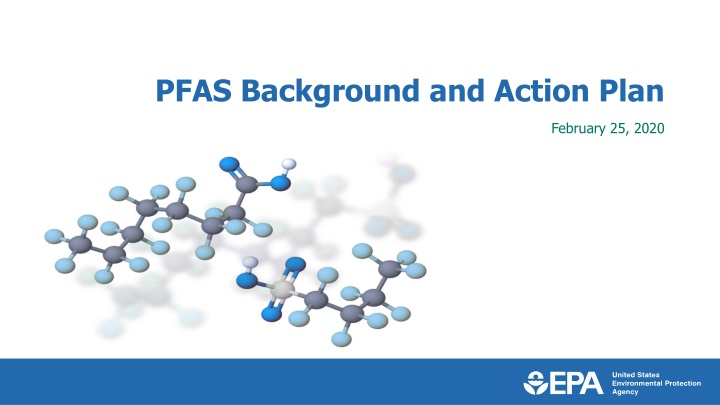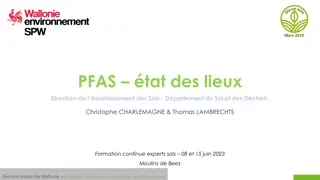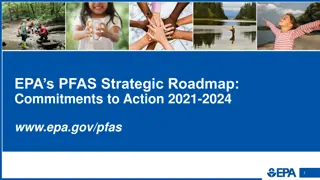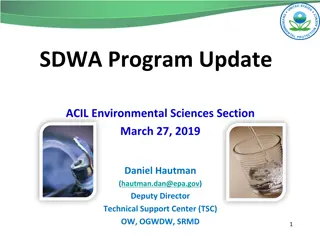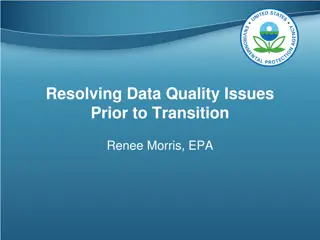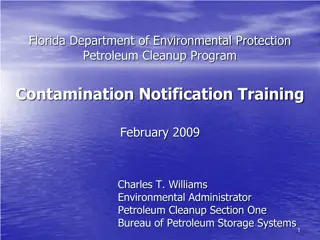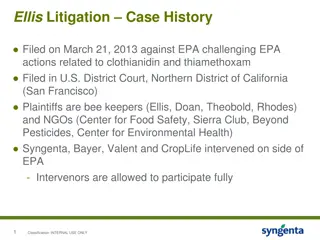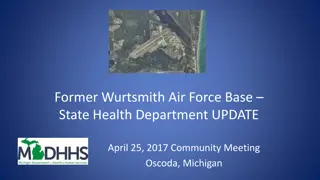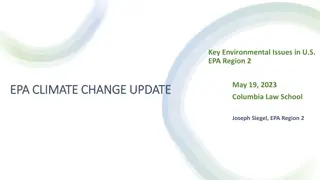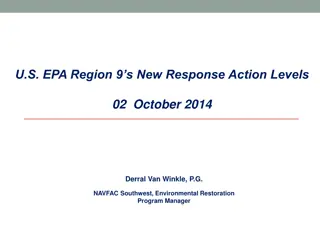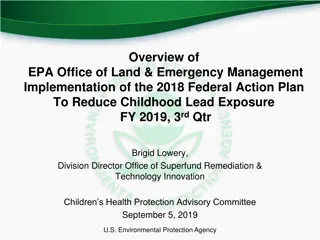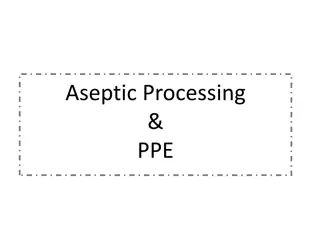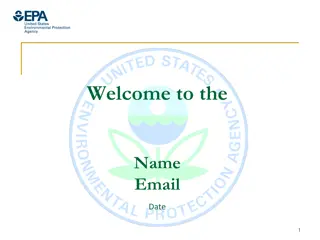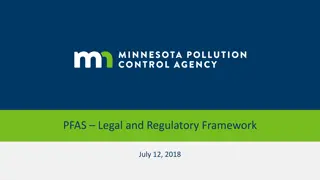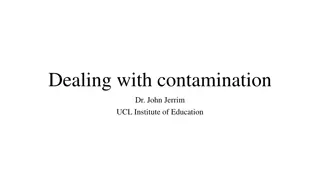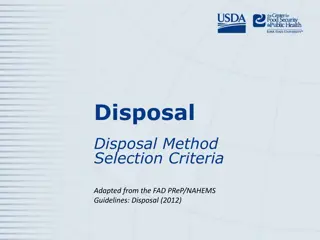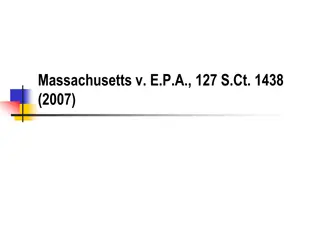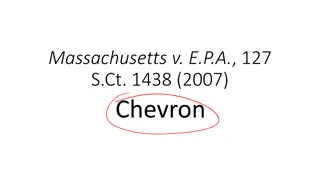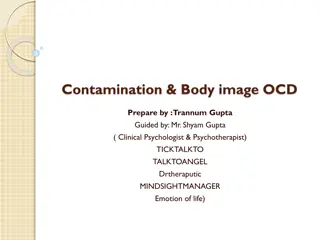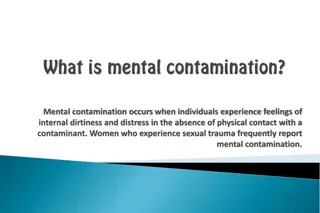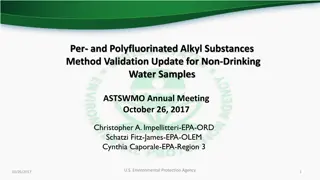EPA's PFAS Action Plan: Addressing Potential Health Risks and Environmental Contamination
Per- and polyfluoroalkyl substances (PFAS) pose a significant environmental and health concern due to their widespread use and persistence. EPA's PFAS Action Plan, developed based on extensive feedback and comments, outlines a comprehensive approach to address these challenges. The plan focuses on regulating drinking water, cleanup efforts, and nationwide monitoring to mitigate PFAS exposure and contamination risks.
Download Presentation

Please find below an Image/Link to download the presentation.
The content on the website is provided AS IS for your information and personal use only. It may not be sold, licensed, or shared on other websites without obtaining consent from the author.If you encounter any issues during the download, it is possible that the publisher has removed the file from their server.
You are allowed to download the files provided on this website for personal or commercial use, subject to the condition that they are used lawfully. All files are the property of their respective owners.
The content on the website is provided AS IS for your information and personal use only. It may not be sold, licensed, or shared on other websites without obtaining consent from the author.
E N D
Presentation Transcript
PFAS Background and Action Plan February 25, 2020
Background Per- and polyfluoroalkyl substances (PFAS) are a group of man-made chemicals that have been in use since the 1940s. PFAS are (or have been) found in a wide array of consumer products like cookware, food packaging, and stain and water repellants used in fabrics, carpets and outerwear. PFAS can also be found at manufacturing and processing facilities, and airports and military installations that use firefighting foams which contain PFAS. 2
Background Because of their widespread use and environmental persistence, most people have been exposed to PFAS chemicals. Some PFAS chemicals can accumulate and can stay in the human body for long periods of time. There is evidence that exposure to certain PFAS may lead to adverse health effects. 3
Action Plan Background EPA s PFAS Action Plan was developed based on feedback from various community events in addition to information received from approximately 120,000 comments submitted to the public docket. The Action Plan is EPA s first multi-media, multi-program, national research, management and risk communication plan to address a challenge like PFAS. Over the past year, EPA has aggressively implemented the PFAS Action Plan and has made progress in all of the program areas. 4
Highlighted Actions Drinking Water On February 20, 2020, EPA took another important step in implementing the Agency s PFAS Action Plan by proposing to regulate PFOA and PFOS drinking water. EPA is also asking for information and data on other PFAS substances, as well as seeking comment on potential monitoring requirements and regulatory approaches EPA is considering for PFAS chemicals. The Agency will review and consider comments received on this action then take the next appropriate steps. On December 19, 2019, EPA accomplished a key milestone in the PFAS Action Plan by publishing a new validated methods to accurately test for 11 additional PFAS in drinking water. EPA s new validated Method 533 focuses on short chain PFAS, those PFAS with carbon chain lengths of four to 12. Method 533 complements EPA Method 537.1 and we can now measure 29 chemicals. 5
Highlighted Actions Cleanup On December 19, 2019, EPA issued Interim Recommendations for Addressing Groundwater Contaminated with PFOA and PFOS, which provide guidance for federal cleanup programs (e.g., CERCLA and RCRA) that will also be helpful to states and tribes. The recommendations provide a starting point for making site specific cleanup decisions and will help protect drinking water resources in communities across the country. EPA will follow through on the regulatory development process for listing certain PFAS as hazardous substances under CERCLA. Monitoring EPA will propose nationwide drinking water monitoring for PFAS under the next UCMR monitoring cycle. 6
Highlighted Actions Toxics Recently, EPA issued an advanced notice of proposed rulemaking, and issued a supplement proposal: On December 4, 2019, an advanced notice of proposed rulemaking was published in the Federal Register soliciting input on adding PFAS to the Toxics Release Inventory toxic chemical list. On February 20, 2020, EPA issued a supplemental proposal to ensure that new uses of certain persistent long-chain PFAS chemicals in surface coatings cannot be manufactured or imported into the United States without notification and review under TSCA. 7
Highlighted Actions Surface Water Protection EPA plans to develop national Clean Water Act human health and aquatic life criteria for PFAS, as data supports. EPA is examining available information about PFAS released into surface waters by industrial sources to determine if additional study is needed for potential regulation in this area. Biosolids EPA will be developing risk assessments for PFOA and PFOS to understand any potential health impacts. 8
Highlighted Actions Research EPA continues to compile and assess human and ecological toxicity information on PFAS to support risk management decisions. EPA is completing peer-reviewed toxicity assessments GenX chemicals and PFBS. EPA is developing peer-reviewed toxicity assessments for PFBA, PFHxA, PFHxS, PFNA, and PFDA to support stakeholders. EPA is applying high-throughput toxicology testing to study the toxicity of the larger universe of PFAS. 9
Highlighted Actions Research, continued EPA continues to develop new methods to test for additional PFAS in drinking water. The Agency is also validating analytical methods for surface water, ground water, wastewater, soils, sediments and biosolids; developing new methods to test for PFAS in ambient air and in emissions; and improving laboratory methods to discover unknown PFAS. EPA is developing exposure models to understand how PFAS moves through the environment to impact people and ecosystems. 10
Highlighted Actions Research, continued EPA continues to assess and review treatment methods for removing PFAS in drinking water. EPA is working to develop tools to assist state and local officials with the cleanup of contaminated sites. EPA is evaluating the effectiveness of technologies and evaluating data on methods for managing the end-of life disposal of PFAS-contaminated materials e.g. via landfills, incineration, and other technologies. EPA is funding research to generate science-based recommendations for managing PFAS in rural and agricultural areas, and to expand the understanding of environmental risks posed by PFAS in water and waste streams. 11
Highlighted Actions Enforcement EPA continues to use enforcement tools, when appropriate, to address PFAS exposure in the environment and assists states in enforcement activities. Risk Communications EPA is working collaboratively to develop a risk communication toolbox that includes multi-media materials and messaging for federal, state, tribal, and local partners to use with the public. 12
Collaboration EPA is collaborating with many federal and state partners to take action, including with: Environmental Council of the States (ECOS) to ensure state priorities are addressed. USDA and FDA to examine the impacts of PFAS on agriculture, rural communities, and food supplies. National Institute of Environmental Health Sciences (NIEHS) National Toxicology Program on assessing PFAS toxicity. DOD on analytical methods and approaches for PFAS cleanup. 13
Questions? 14
Thank you 15
